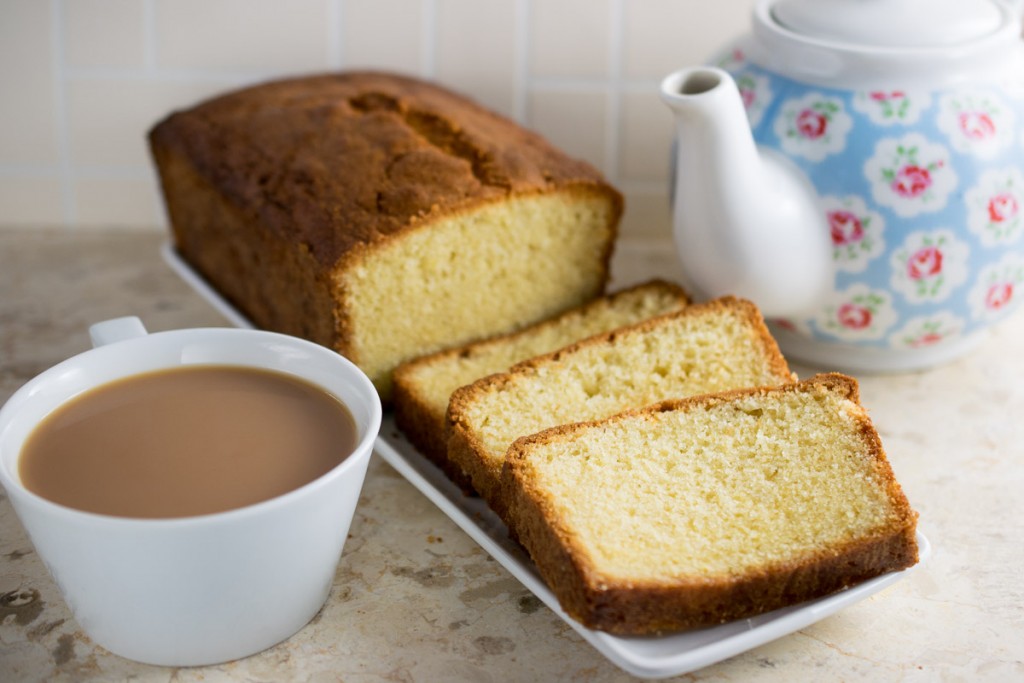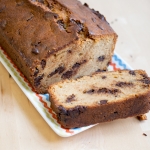There are some recipes which are so classic as to become iconic. Victoria Sponges are a case in point. Anyone partial to a slice of this cake with their mid-afternoon coffee will have specific set of expectations of what a true Victoria should taste like and there’s nothing quite like the disappointment if your slice is poorly risen, has a dry crumb or isn’t anything other than featherlight in it’s structure.
Victoria Sponges may be known the world over, and I must say, I really do adore a homemade one, but Hungry Hubby has always, always loved a more modest but still quintessentially British bake. The Lemon Madeira Cake.
This is one of those recipes which is a little bit deceptive in it’s simplicity. It’s a bake I have been making since I was a tiny tot but if I am honest, the recipes I tried always left me wanting something more. If you have ever bought a decent madeira cake, and you certainly can buy a good one, then you will know this perfectly plain loaf cake is really characteristic.
It has the finest crumb of any cake I can think of and the crack which appears upon baking is pretty much a badge of honour! The more furrowed, the more successful your madeira baking has been. It took me a lot of years to discover how to produce this tight and exceedingly regular crumb which symbolises this special cake and I’m so happy to be able to share the secrets with you now too.

Madeira cake actually originated in the 1700-1800s of England and it was served as an accompaniment to a glass of madeira wine. It sadly didn’t hail from the sunny shores of the Portuguese islands of Madeira and although they do make their own national cake, it’s not very similar to the British one. Ours is austere looking but Hungry Hubby loves it when I add lemon and a good splash of vanilla – the original cake would most likely have had neither of these so it really was exceedingly plain.
You could pick one or the other if you prefer. It’s the method which makes a madeira worthy of it’s name! And speaking of that, it was a chance finding, an article by Dan Lepard, one of my baking heroes that lead me to develop my own madeira. You can read about his technique and his toasted almond version of the madeira cake here.
In it’s simplest form, a madeira is equal weights of butter, caster sugar and eggs but pretty much all recipes have a higher proportion of flour (compared to a Victoria where they are all equal measures). This straight away helps with producing a closer-crumbed texture but it is Dan’s discovery of the old method of making a “flour batter” which is the winning step.
You see, you beat half the flour into the creamed butter and sugar before beating in each egg. Only then, do you fold in the remaining flour and raising agent. It sounds utterly bizarre, it will feel really weird for classical home bakers who would never “work” flour this much but I promise you, the madness in the method brings the magic of the madeira!
This recipe is more detailed than most simple cake recipes but I hope it gives you all you need to produced a perfect and proper madeira, befitting of your afternoon cuppa, every time. Do read it through before starting as it will feel strange the first time you try this method! If you too have been disappointed by or didn’t even see the point of a madeira before now, then I hope this recipe will change your mind 😀

- 175 soft butter
- 175 g caster sugar
- 1 tsp lemon zest
- 1 tsp vanilla extract
- 30 ml whole milk 2 tbsp
- 230 g plain flour
- 3 large eggs
- 2 rounded tsp baking powder
-
Start by greasing and lining a 2lb (900g) loaf tin with baking parchment - use two overlapping pieces so the ends and sides are both lined. It helps with unmoulding later greatly.
-
Preheat the oven to 160˚C and position a shelf lower down so the cake sits no higher than the middle of the oven - any higher and it could catch before being cooked through.
-
Cream the butter, sugar and lemon zest together until very light, pale and fluffy - this takes me 10 minutes in my stand mixer during the winter, as room temp is never that warm!
-
Beat in the vanilla then with the mixer running, dribble in the milk very slowly (just like making buttercream - you want the creamed mixture as soft and light and fluffy as possible before you add the flour).
-
Now here comes the odd part - add half of the flour into the creamed butter and beat until no streaks remain at all. It will go against your better instincts but it works!
-
Beat the eggs in one at a time, adding a spoonful of flour if it looks like it's curdling. When smooth, mix the baking powder into the remaining flour and fold into the batter.
-
Spoon into the prepared baking tin and bake for 50-60 minutes until well risen, pale golden and remember that madeira cakes are supposed to crack - it's part of their charm.
-
Cool on a rack for 10 minutes before removing from the tin. When cool, slice and serve with a hot pot of tea. You should get 10 good slices from one loaf cake.
This cake will keep well for 2-3 days and even, it is better for 24 hours of being tightly wrapped in foil once cold.
This post contains affiliate links, meaning I will earn a little commission if you chose to buy items I’ve advertised, helping me to bring you all these recipes for free
Like this post? Then why not try these related recipes:
- Blackberry & Ginger Crumble Cake
- Luscious Leon Lemon Bars
- Choc Chip Caramel Loaf Cake





I AM NOT SURE WHAT FORMAT YOU USE BUT IT IS MUCH TOO WIDE AND WHEN READING HAVE TO KEEP SLIDING PAGE TO THE RT AND LT AND THEN WHEN YOU TRY TO PRINT IT CUTS OFF THE RT SIDE OF THE RECIPE HELEN
Sent from Mail for Windows 10
Thankyou for the lemon madeira recipe Jo. I will certainly try it. My husband loves cherry madeira and I always use a higher proportion of flour to make sure that the cherries don’t sink to the bottom!
That’s a very good idea Maureen, it really does help to keep them suspended in the batter. This will be easy to adapt to incorporate some cherries.
Happy baking!
As all things seem critical with this cake i.e. Madeira, would you please let me know if 160 is fan or conventional? I’d only ever cooked with a gas oven but since my son rewired the house my new oven is fan and I’ve not quite got the hang of the need to reduce the temperatures stated in recipes, both my own and other people’s.
Love your blog, especially the IP section.
Ta
Hello Catherine – and thanks so much for your kind words, I’m really happy that you are enjoying the blog and recipes. Lots more to come!
As for your question, I am lucky enough to have always had ovens which allow me to turn off the fan at will. *All* of my recipes are written with this in mind (the exception being the macarons, which bake infinitely better with the fan on). In this case, you would be best advised to drop the temperature to 140˚C as your oven is now fan driven. It may be that you need to increase the baking time slightly or you may find you don’t need to drop it a full 20˚ but for the first time, I would play it safe and drop it to 140. I hope that helps and happy baking!
Yum, lemon cake is the best and yours looks delicious!!
Thanks Sam!
Well I am just loving that citrus with this moist cake!
Thanks Rebecca!
This must be THE perfect cake with a cup of tea. I think I need to make one very soon!
It certainly is isn’t it Bintu? You can’t beat it with your midmorning cuppa!
All this cake needs is a cup of coffee…I love a lemon cake like this!
Yep, I’ll get slicing if you put the kettle on Heather! 😀
What a beautiful and simple cake! This is absolutely the perfect cake to ahve with tea.
Absolutely, served on china and with tea from a teapot for full effect 😀
Would this cake work in the honeycomb/bee pan that you did the ginger mojoto cake in?
You could do but it’s a much bigger volume tin – you’ll need to increase the mixture by at least 50%.
I’ve been making cake mixes like this for ages, I haven’t read the method from Dan Leppa. Mine stemmed from a mixture of laziness and curiosity
That’s the best way to bake – just give it a go and see what happens. I’m all for experimenting and fiddling to suit you 😀
Hi Jo,
I love your easy to follow recipes.I made the lemon Madeira for Mothers day and it turned out great and tasted yummy ?xx
Thanks so much Angie! I’m so happy you enjoy using the recipes and that the Madeira cake was well received on Mother’s Day 😀 Thanks for taking the time to comment x
Going to be trying this one (hopefully tonight!) will report back 🙂
Ooo I hope you like it Priya! It’s a Hungry Hubby favourite 😀
I’m in the process of making this cake but I didn’t have a loaf tray so baking in a deep square brownie tin hopefully this works mixture tasted delicious after mixing together, fingers crossed 🤞Will keep you posted x
Hi Paula, I hope you enjoyed the cake! Xx
How much baking powder is a rounded teaspoon?
Basically, dip your tsp into the baking powder and instead of flattening it off with the back of a knife, allow it to be gently rounded. It is an imprecise measure meant to imply use of a “generous” tsp but not quite as much as a tsp and a half, if you can see what I mean. Hope that helps!
I made this on a whim this morning and it’s gorgeous! Very moist and not overpoweringly lemony (from someone who isn’t overly keen on lemon bakes in general). I think I baked it for around 50 mins. Lovely crisp on top and fluffy in the centre. Thanks’
Wonderful! Thank you so much Chloe for your lovely review. I’m so glad you enjoyed the cake xx
My family and I loved it. So tasty and our favorite part is the crunchy edges! The flavor and crumb is phenomenal. Very good with fair-trade vanilla rooibos tea. Thanks Jo! Indeed it is a proper madeirs cake. Thanks for the weight measurements of the ingredients.